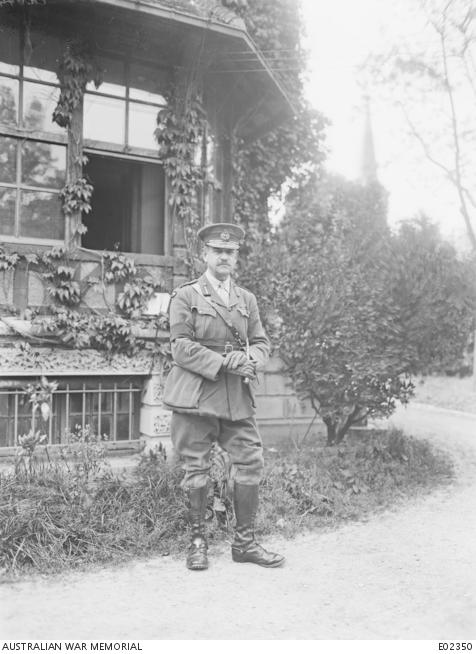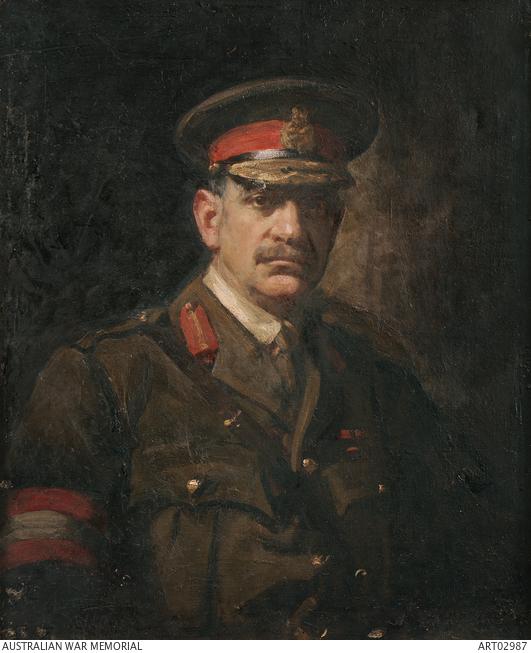1918: Australians in France - General Sir John Monash

Major General John Monash photographed at Glisy, Villers-Bretonneux area, 25 May 1918,
- 1918: Australians in France
- General Sir John Monash
John Monash was born in Melbourne on 27 June 1865, to a family of Prussian Jewish origin. After an education at Scotch College and the University of Melbourne, studying law, arts and engineering, he became interested in the Australian military, and began his service career in 1887. He joined Melbourne University's Metropolitan Brigade of the Garrison Artillery, and until the outbreak of war in 1914, he worked at learning the skills of artillery and engineering, as well as teaching and designing. By 1914, he was in command of the AIF's 4th Brigade in Egypt, where, like most Australian troops, he experienced the disastrous effects of bad organisation and planning, and poor command decisions. It was to be in France in 1918 that Monash would truly make his mark.
After moving to the Western Front in 1916, Monash was promoted to Major General and took command of the 3rd Division. In the years leading to 1918, he and his troops were involved in many confrontations, including the Battles of Messines, the third battle of Ypres, and Polygon Wood, with some successes.
In May 1918, Monash was appointed corps commander of the Australian forces, and in that year he led some significant attacks by Australian troops in the final stages of the war. Monash's troops were involved in helping to stem the March German offensive. But it was during the battle at Hamel that Monash really secured his reputation. Monash's skilful planning and attention to detail resulted in a triumphant attack and capture of the town by Australian and American troops. This was the beginning of a series of successful campaigns by Australians that continued until their last battle in October.
Monash wanted to move away from what he considered to be outdated British tactics, believing that
the true role of infantry was not to expend itself upon heroic physical effort, not to wither away under merciless machine-gun fire, not to impale itself on hostile bayonets, but on the contrary, to advance under the maximum possible protection of the maximum possible array of mechanical resources, in the form of guns, machine-guns, tanks, mortars and aeroplanes; to advance with as little impediment as possible; to be relieved as far as possible of the obligation to fight their way forward.
He supported the view that the most effective warfare involved many different types of weaponry and defences working together- the whole being greater than the sum of its parts.
Monash was also a brilliant tactician. For example, he was renowned for the idea of bombarding German lines with gas and smoke shells together for a few days prior to an attack, so that the Germans were conditioned to associate the gas with the smoke. However, on the day of an attack, only smoke shells would be fired. This not only provided a smokescreen for the advancing troops, but it also caused the Germans to put their gas masks on automatically, which distracted them and caused confusion, impairing their visibility and communication.
The main thing is always to have a plan; if it is not the best plan, it is at least better than no plan at all.
Known as a meticulous planner, Monash held conferences with his officers before operations to generate ideas, to elucidate any problem areas, and to make sure that all involved were fully versed and familiar with the plan.

Lieutenant General Sir John Monash by John Longstaff,
Monash was knighted for his services in 1918, after the 8 August advance. He continued his commitment to the war in the formidable task of organising demobilisation and the return home of Australian personnel.
After the war, he worked in many prominent civilian positions, the most notable being head of the Victorian State Electricity Commission, a role for which he continues to be respectfully remembered. He was a leading and loved public figure after the war, becoming involved in many public and private organisations, such as the Boy Scouts, and in the commemorations of Anzac Day. Monash was honoured with numerous awards and decorations from universities and foreign governments. Monash University in Melbourne, Victoria, is named after him.
General Sir John Monash died in October 1931. Field Marshal Montgomery, the famous British army commander in the Second World War (a junior officer in the First World War), later wrote:
I would name Sir John Monash as the best general on the western front in Europe.
John Monash will continue to be remembered as one of the greatest figures in Australian history.